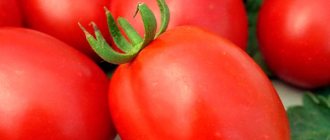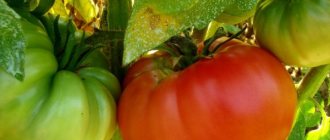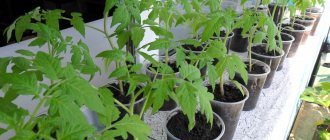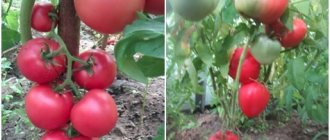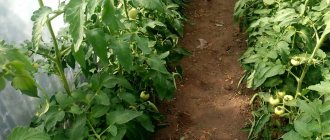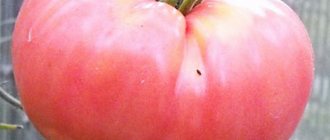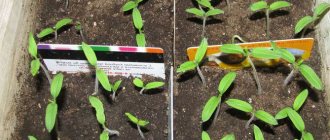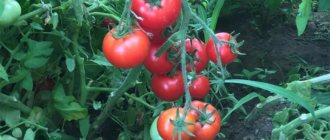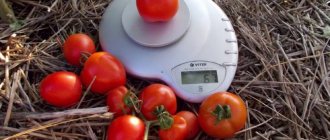Description of the variety
The “Pink Elephant” tomato is a semi-determinate type of tomato, created by Russian scientists in the late 90s of the last century and originally intended for cultivation in greenhouse conditions. However, many gardeners manage to reap good harvests by growing it in open ground.
Distinctive features
The variety is ideal for salads . But lovers of sweet and thick juices use these tomatoes to make them. Among its relatives, it is considered a delicacy, so it is not practical to make juices, pastes, or lecho from it. It is also important to remember that ripe fruits are not stored for a long time.
Fruit characteristics and yield
The fruits of the Pink Elephant variety have a slightly flattened shape and a bright pink color . The average weight of a tomato is 300 g, some of them reach 1000 g. The fruits are dense, fleshy, with a small number of seeds and thin skin. From one 1 m² you can harvest up to 8 kg of crop. You will be able to try them within 110 days after the seeds germinate.
Reference. Gardeners note average yields compared to other tomatoes, but choose “Pink Elephant” for its taste and presentable presentation, which allows the fruits to be successfully used for commercial purposes.
The photo speaks more than eloquently about this variety.:
Description and characteristics of the Pink Elephant tomato variety, reviews, photos
Mid-season, semi-determinate, large-fruited tomato variety for open ground and greenhouses. The period from germination to the beginning of ripening is 110-115 days.
The bush is powerful, spreading, 1.5-1.6 meters high . Potato type leaf. The inflorescence is intermediate. The first inflorescence is laid above the 7th leaf, subsequent ones - every 2-3 leaves. Requires tying to the support and pinning. The best results were obtained when forming a plant with 1 or 2 stems.
Basic qualities of fruits
The fruits are flat-round, ribbed at the stalk, pink in color at maturity, weighing 250-300 grams , fleshy, excellent taste. These tomatoes are universally used - good for both fresh salads and for canning in pieces and making juice and sauce.
The bunches of tomatoes turn out to be very heavy, so it is advisable to tie them up as the fruits fill.
Productivity of the variety : 6.2-8.2 kg/sq.m (subject to agricultural technology).
A site about tomato varieties with truthful reviews from gardeners - Tomatland.
How to grow seedlings
Another feature of the “Pink Elephant” is that it is grown only by seedlings, regardless of climatic conditions.
Seed preparation
Step-by-step steps for preparing seeds for planting are as follows::
- At the beginning of March, it is necessary to begin preparing seeds for seedlings in order to sow them in the second half of the month. In warm regions, seeds begin to be prepared earlier, and so are planted accordingly. To begin, treat the material purchased or prepared from the last harvest in a solution of potassium permanganate for about 30 minutes. We throw away the floating seeds; they will not sprout.
- After treating with potassium permanganate, rinse them under running water.
- Dry the resulting seeds.
- For a successful harvest, fertilizing should begin from the seeds. Before sowing, we treat the seeds with growth stimulants, for example, “Immunocytophyte”, “Agat-25K”, or a natural stimulant - aloe.
- Seed germination consists in turn of the following stages:
- Pour water into a shallow plate, place gauze or other cotton material;
- put the seeds;
- cover with the same material;
- watch when the seeds break through.
Container and soil
To plant sprouted seeds, it is recommended to prepare:
- thin plastic containers with lids;
- deep containers with a tray and drainage.
Use purchased soil recommended for sowing peppers and tomatoes , or you can mix the soil in which the seedlings will be planted with ash, humus and sand (ratio 2:1:1:1).
Landing
Despite the unpretentiousness of the Pink Elephant, it is necessary to provide these bushes with appropriate care.
Growing seedlings
When purchasing seeds, you should carefully study the label. It indicates the optimal sowing time and stages of caring for growing bushes. The optimal time for sowing is March. Determining a more accurate date is influenced by the climatic conditions of each region.
Hermetically sealed containers are suitable for sowing. For sowing you need:
- Fill containers with growing soil intended for tomatoes.
- Soak the seeds in potassium permanganate. Only seeds that have settled to the bottom are suitable for sowing.
- Wash the settled seeds and plant them in the soil. There should be a layer of soil about 1 cm high above the seeds.
- Sprinkle the ground with water.
- Cover the container and place in a warm place.
After about seven days, the first shoots appear. When you see them, you should move the containers to a cooler place. At the same time, it must have enough lighting. Watering should be regular.
After the first pair of leaves appear, seedlings should be planted in separate containers. At the same time, the plants are fed with mineral fertilizers.
Landing in the ground
At the end of April, grown tomatoes can be planted in a heated greenhouse. They are salted in an unheated greenhouse at the end of spring, and in open ground in early June.
It is worth planting two bushes per 1 square meter. The soil is first fertilized with organic and mineral substances.
How to grow tomatoes
After the seedlings have grown and are ready to be transplanted into the ground, it is recommended to harden them off . We carry out hardening in stages: first, a few minutes a day (from 10 minutes), and then gradually increase the hardening time to 12 hours.
After this, we move on to planting plants .
Landing
Before planting seedlings, the soil must be well fertilized with organic matter and a mineral complex - such as “Krepysh”, “Nitroammofoska” or “Kemira Lux”. It is recommended to dig up the soil with a large amount of humus and ash, provide it with complex fertilizer and superphosphate, and then cover it with film for 7 days. This way the earth will warm up and be saturated with vitamins.
Reference. At the beginning of June, seedlings are planted in open ground, in the second ten days of May - in greenhouses or greenhouses, and in the 20th of April, seedlings are planted by owners of heated greenhouses.
How exactly to plant plants? Plant 1-2 bushes per 1 m². We make a large hole, plant a sprout, and cover it with wood ash on top . If you plant more, the plants will not have enough light and space later.
Care
After planting the seedlings, the next important stage begins - proper care.:
- watering once a week at the rate of 0.5 buckets per 1 bush;
- after watering, you need to ventilate the room where the tomatoes grow;
- It is important to constantly loosen the soil, but you should not hill up right away;
- It is necessary to remove the stepsons, otherwise the bush may not withstand the load. It is recommended to leave no more than two stems. We remove the stepsons throughout the development of the plant in the early morning, after watering;
- You also need to remove excess flower ovaries, leaving no more than four flowers;
- Be sure to tie up each bush, otherwise it will break under the weight of the harvest. When tying, we use two wires for better stability;
- Since this variety produces large fruits, the plants need to be fertilized frequently and abundantly (3-4 times per season). After flowering, phosphorus, nitrogen, and potassium are well suited; during the growing season, mineral complexes and organic fertilizers are suitable.
By following these simple rules, you will be rewarded with a bountiful and tasty harvest..
Features of cultivation and possible difficulties
The growing procedure is similar to that usual for most tomatoes, but there are some features :
- It is recommended to water tomatoes only with warm water;
- after watering, be sure to loosen the soil and prevent the formation of a crust on the ground;
- molding and pinching of the bush are required;
- After fruit formation, inspect the bushes daily to avoid stress on the stem with branches and fruits, which could cause it to break.
More about tomatoes:
A recognized favorite among gardeners is the “Rosy Cheeks” tomato.
Delicious, sweet and juicy tomatoes “Podsinsky miracle”
Diseases and pests
"Pink elephant" is resistant to tomato diseases . However, like any other variety, it is not 100% immune from them, including late blight (the appearance of dark spots on leaves and fruits). If you find signs of this disease, start treatment immediately.
It takes place in 2 stages:
- We fertilize the soil with potassium to avoid re-infection.
- We treat tomatoes with fungicides containing copper. They will heal the plants.
In addition, tomatoes are not immune to insect pests . To prevent their occurrence, experienced farmers advise planting plants between the rows whose smell repels pests.
If they still start, do the following::
- when aphids appear, treat the plants with a solution of soap and water;
- if there are slugs, we collect them manually, after which we treat the plantings with a solution of ammonia and water;
- When spider mites or whiteflies appear, we treat with a decoction of celandine, onion peel or chamomile.
To avoid the appearance of insects or late blight, use preventive measures - this way you can avoid additional problems.
The nuances of growing in open ground and in a greenhouse
The Pink Elephant tomato variety is more suitable for growing in a greenhouse . But some gardeners also grow it in open ground. Let's note some nuances of growing :
- If you decide to grow tomatoes in a greenhouse, remember that pollination difficulties may arise in such conditions. Be sure to ventilate greenhouses, otherwise pollen will clump. Some gardeners pollinate by hand;
- When growing in open ground, the plantings must be covered with film. Pollination in this case occurs naturally.
Features of cultivation
Tomatoes of the Pink Elephant variety are grown by seedlings.
Seedlings are planted in a permanent place according to the following scheme:
- When forming a bush of 1 stem per 1 sq. m. place 4 plants;
- When forming a bush with two stems, the number of plants is reduced to 2 pieces. per 1 sq. m.
To grow this variety, it is best to buy seeds in specialized stores. Seed material is sown in mid-March. Before this, it must be treated in a weak solution of potassium permanganate and kept in a growth stimulator Zircon for 10 hours.
The seeds are buried 2 cm into the soil, maintaining an interval between them of about 1.5-2 cm. Next, the plantings are watered with warm water using a spray bottle. Cover the containers with film or glass and leave them in a warm place until green sprouts appear on the surface of the earth. Next, the film is removed and the containers are transferred to a well-lit place.
When the seedlings have 2 true leaves, they are planted in separate cups of larger volume.
Advice! If you use peat cups when picking, they can be buried directly into the ground along with the seedlings. This will keep the root system of the seedlings intact.
The seedlings are transferred to the greenhouse in May, when the threat of frost has passed.
This variety is recommended to be grown in greenhouse conditions. When cultivating in open ground, experts advise using film cover.
To get a good harvest of tasty and ripe tomatoes, the Pink Elephant tomato variety must be fertilized with mineral fertilizers:
- Before planting, add organic matter and a mineral complex of fertilizers.
- At the beginning of the growing season and further processing, NPK with a predominance of potassium is added. How else can you feed tomatoes, read the article...
Advice! In the second half of the growing season, it is undesirable to introduce organic matter.
More information about growing tomatoes is described in the article: Technology of growing tomatoes. Secrets of planting and care
You might be interested in: How to properly plant tomatoes in a greenhouse: bush formation diagram, care features, photos and videos
Useful information: How to properly tie tomatoes in open ground: the best methods, step-by-step photo and video instructions
Harvesting and application
The fruits of the “Pink Elephant” are used mainly fresh . They are also used for preparing canned products - lecho, juices, pastes.
The harvest is not stored for a long time . Tomatoes are placed in boxes and stored in a dry, dark place. It is important that the tomatoes themselves are also dry.
Reference. Ripe fruits are removed from the bush early in the morning. Gardeners note that if you pick green or brown fruits, then after ripening on the windowsill they will not lose their taste.
Reviews
I always plant tomatoes in my garden.
I really like the fruits of Pink Elephant tomatoes. I bought its seeds last year at the market. One pack contained only 1 gram of seeds and they cost 25 rubles. The cost of seeds is not high, considering the yield of this variety. The tomatoes are not early. They have an average ripening period. Tomatoes live up to their name. They are very large and juicy inside. I always sow seeds for seedlings. This way I get an earlier harvest of vegetables. I remove the first tomatoes of the Pink Elephant variety from the bushes 112 days after sowing the seeds in the ground. I plant tomato seedlings in a greenhouse in May. There it grows quickly and produces a good harvest of fruit. Tomatoes of the Pink Elephant variety form medium-sized bushes. Each of them bears from 6 to 8 tomatoes. They are rounded and flattened, dark pink in color. The fruits are quite large. I have not had a fetus weighing less than 300 grams. From one bush I collect at least four kilograms of tomatoes. The tomatoes are very juicy and tasty. They have juicy flesh. The large mass of tomatoes allows me to make tomatoes from them. I eat fresh tomatoes, add them to salads, and use them in cooking. I like this variety not only for its productivity and excellent taste, but it is also resistant to viral diseases and a number of diseases. To get a good harvest, it is enough to water the plants on time, loosen and fertilize. I fertilize them only with organic matter. tutsa
https://otzovik.com/review_2964345.html
The Pink Elephant variety received such an attractive name for its huge pink fruits.
Adherents of gigantomania will certainly love it, and perhaps they will be able to grow a fruit weighing more than a kilogram. This beauty appeared on my site a long time ago. I don’t grow it every year, but I return to it periodically. Everyone wants to find a worthy replacement for it, so that the fruits are huge and there is an enormous amount of them on the bush, and the taste is not watery. But, as you know, the larger the tomato, the fewer fruits on the bush. Although it cannot be called a barren harvest, since a dozen Pink Elephant tomatoes will fill a bucket. The fruits differ not only in size, but also in their pleasant taste - a lot of meat, few seeds. They make excellent tomato juice. Pink elephant is medium-early in terms of ripening and, thanks to this, it can be grown both indoors and outdoors. In a good summer, the first two clusters successfully ripen in our Perm region. Well, the rest have to be ripened indoors. The bushes are tall, in the greenhouse they rest against the ceiling, so already in the 20th of July they have to be pinched. On the ground they reach 1.5 meters in height. They require pinching. Despite the fact that the manufacturer assures that the variety is resistant to late blight and other diseases, Pink Elephant, like other large-fruited plants, is susceptible to various tomato diseases. But this does not mean that you need to give up growing delicious tomatoes! You just need to follow the technology of growing tomatoes: carry out preventive treatments of the bushes with phytosporin, tie up the bushes in a timely manner and remove leaves touching the ground. Despite all the difficulties of growing large and tasty tomatoes, a real gardener will never exchange them for unpretentious wooden hybrids. nechaevatu
https://otzovik.com/review_2964143.html
Video review about growing Pink Elephant tomatoes
The Pink Elephant harvest will definitely please anyone who tries to grow this wonderful variety of tomatoes.
The productive, sugary Pink Elephant is especially good for growing in a small country garden. There will be something to please yourself and boast to your neighbors of a truly “elephant” harvest of your favorite tomatoes.
- Author: Natalya Stepanova
My name is Natalya. By profession I am a teacher of Russian language and literature. Rate this article:
- 5
- 4
- 3
- 2
- 1
(1 vote, average: 5 out of 5)
Share with your friends!
Advantages and disadvantages of the variety
Like any variety, “Pink Elephant” has both advantages and disadvantages . Let's take a closer look at them.
The advantages of the variety include:
- large fruit sizes;
- original and rich taste;
- high productivity;
- disease resistance;
- high content of beneficial amino acids;
- the opportunity to prepare seeds for next year from the resulting harvest.
Flaws:
- tomatoes spoil quickly;
- after temperature changes, the fruits crack;
- tomatoes are not resistant to fungal infections;
- it is necessary to strictly observe the temperature regime of cultivation;
- The formation of a bush is mandatory.
Care
Providing appropriate care for the Pink Elephant variety will allow you to get large fruits. To form a bush, remove excess shoots. This procedure is carried out in the morning. In the evening before planting, you should water the bushes generously.
Since the Pink Elephant variety is tall, it should definitely be tied up. You need to secure trunks, brushes and shoots. It is recommended to leave 3-4 flowers on the lower pair of inflorescences, and 4-6 on the third. The excess should be cut off before the buds open.
Every week you should tear off 1-2 bottom leaves.
Organic and mineral fertilizers should be added to the soil as top dressing in the first half of the growing season. When forming fruits, only mineral feeding is used. The addition of phosphorus, nitrogen and potassium has a particularly beneficial effect on tomato growth.
Watering should be regular and plentiful. You should use warm water for this. Covering the soil with a layer of grass, sawdust or straw will help prevent moisture evaporation.
The collected fruits can be stored for about a couple of weeks. For better preservation, they should be laid out in a cool place.
Farmer reviews
Let's consider some reviews from summer residents and gardeners about growing the "Pink Elephant".
Tatyana : “ Pink Elephant” is one of my favorite varieties of tomatoes. It is moderately juicy, meaty and sweet, the tomatoes grow large. Just a few bushes are enough for our small family.”
Igor : “I’ve been planting the Pink Elephant tomato for three years now. Amazing taste, high yield. But the skin is thin. I don’t think it’s suitable for sale.”
Vasily : “It was not possible to reap a good harvest. The taste is fresh. The bushes are sick. The treatment didn't help. I probably won’t plant any more.”
About proper care
The Pink Elephant tomato is not a variety that will delight you with abundant harvests. In the best case, a gardener will remove 8-9 fruits from one bush, but the total weight of the harvest will be 3-4 kilograms. To achieve such results, you will have to work hard.
Here's how to care for a Pink Elephant tomato:
- Due to a certain habit, the bushes are formed into one or two stems - the plant simply cannot withstand more ovaries and shoots.
- The gardener must remove the remaining stepsons at the entire stage of tomato development. It is better to do this in the morning, watering the beds abundantly the day before.
- It is imperative to tie up the Elephant bushes. It is even better to use two wires for greater reliability. Not only the stem and shoots are tied up, but also the fruit clusters themselves, because the mass of the lower ones can reach 1.5 kg.
- The Pink Elephant needs to be fed generously and often, otherwise it will not “pull” such a mass of tomatoes. In the first half of vegetative development, both organic and mineral fertilizers are used. After flowering, it is recommended to use only mineral complexes or individual substances. Tomato responds especially well to potassium, nitrogen, and phosphorus.
- It is necessary to normalize not only the shoots, but also the number of flowers. It is recommended to leave 3-4 inflorescences on the first two brushes of the Elephant, the third brush is also thinned out, leaving 4-6 flowers. Flowers are picked off at the bud stage before they open.
- The lower leaves of massive bushes also need to be torn off. Every week they pick one or two leaves. No more leaves can be removed, as plant photosynthesis will be disrupted. If you do not touch the leaves at all, the risk of tomato infection with fungal infections will increase significantly.
- Water the Elephant abundantly and often, using warm water. To reduce moisture evaporation, cover the ground with straw, sawdust or plucked grass.
- To prevent infection of tomatoes, preventive treatment of bushes against the most common diseases and pests is carried out. Disinfection must be completed before fruit formation.
Attention! In a greenhouse or greenhouse with high humidity, the pollen of the Pink Elephant tomato clumps and therefore does not transfer well from flower to flower. In order for tomatoes to be pollinated normally, you need to ventilate the greenhouse and control the level of humidity inside it. The gardener may have to “help” the tomatoes and pollinate them by hand.
The harvested crop can be stored for several weeks. To do this, place the tomatoes in clean, dry boxes and place them in a cool, dark place. If necessary, the harvest can be transported to any distance - the fruits perfectly retain their shape and taste.
How to grow tomatoes correctly
Every gardener knows how difficult it is to grow tomatoes; they are one of the most difficult crops to grow. Growing Pink Elephant tomatoes will also require you to expend effort and energy, but it will pay off with delicious pink fruits.
This variety requires a seedling method of cultivation and pre-treatment of planting material.
- The seeds should be soaked in a manganese solution, then washed and dried, after which they are immersed in a growth stimulator or aloe juice for a day.
- Next, you will need gauze in which the seeds are placed and left in warm water for germination.
- Planting boxes must be filled with a mixture of peat, soil, humus, ash and sand.
- The soil is moistened and seed planting begins. They should be 1.5 cm apart from each other. They are sprinkled with soil on top and moistened again.
- After the seedlings are planted above the soil, a mini greenhouse should be installed, so the humidity will remain longer and a certain microclimate will arise inside.
- After the emergence of seedlings, the greenhouse is often ventilated, and when two true leaves appear, the seedlings must be pruned.
- Two weeks after transplanting, the seedlings need to be fed with complex fertilizer.
- By the end of May, you can transplant plants into the greenhouse at a distance of no more than two bushes per square meter.
Before the seedlings “move” to their permanent place of residence, the bed should be treated with a manganese solution, and then compost or humus should be added to it. Many gardeners use their own folk methods of feeding, for example, chopped nettles, small fish, onion peels and even chicken feathers are placed in the planting hole, in the hope that such a layer will enrich the plants with all the necessary elements.
The fertilizing that tomatoes require must be done at least 4 times per season:
- The first is done before fruit formation: saltpeter is added.
- The second is accomplished by superphosphate and sulfite.
- The third is fermented manure along with grass.
- The fourth is complex fertilizer.
If all activities are carried out on time and correctly, then up to 6 tomatoes will form in the bunches.
And yet, tomatoes are heavy and powerful; often, if the garter is poorly tied, the stems break and the harvest is lost, so the future harvest and the health of the bushes depend on the strength of the garter. Make sure that the trellises or ropes are strong and do not break under the weight of the brushes; it is good if it is a wire material.
I bought the seeds and here are the questions... +++
Elena Orlova
Yes, if you cut an onion, it’s a perennial one, and if you pull it out (with an onion), then it will be an annual one. As for the seeds, cranberries in sugar are exactly the same as a balcony miracle, potted, pink elephant is not only packaged by Aelita. respectively large and pink, good fleshy, Agata is productive, there is a lot of it on the bushes, Alpatieva is an old variety. but I don’t plant it, Phoenix, in my opinion, is a late-ripening cucumber, although it’s as classic as cucumbers used to be and delicious. Finger and Erokha are also normal, but they are all bee-pollinated. I try to buy self-pollinating ones, they are still more productive (we have a problem with bees)
Elena Smirnova
Of all the above, I used to plant Phoenix cucumbers. Excellent, productive, bee-pollinated. But there is an advantage to this - you will have your own seeds. Bull's heart. Maybe it’s good that we couldn’t buy it. I’ve heard complaints that lately they’ve mostly been selling “counterfeits” of the Bull’s Heart.
Valentina Golovko {Spasenova}
Onion Batun - perennial onion for greens. you won't have a head from it. You won’t be able to harvest any greenery the first year either, but in the spring of next year and in the fall you will always have tender greenery. Don't worry about cutting, it will grow back.
Tina Ezdakova
onion is a very good perennial onion. no need to dig. From the above I grew Finger - good cucumbers. determinant means low. not requiring pinching and shaping
Description of fruits
The characteristics of the fruits of this variety will help distinguish them from other types of tomatoes.
On average, each plant bush has about 5-7 tomatoes. The fruits are quite heavy and the weight of each of them is 300-400 g. Some tomatoes from the first bunch can weigh more than a kilogram.
The fruits are pinkish in color and have an oval shape. At the top the surface of the tomato is smooth, and near the stalk it is slightly ribbed. Tomatoes are covered with a thick, glossy skin, under which there is a fleshy pulp. It has a slightly sweetish and rich taste, which is devoid of characteristic sourness.
See also
Characteristics and description of the Ural early tomato variety, plant heightRead
Resistance to diseases and pests
The Orange Elephant tomato has good immunity, resistance to temperature changes, and is almost not susceptible to disease. Therefore, it is better to take the necessary preventive measures in advance so as not to have to deal with diseases or pests later:
- compliance with simple and unburdensome rules of agricultural technology for this variety;
- maintain the distance between tomato bushes;
- regularity of watering;
- temperature and light conditions;
- fertilizing: specified proportions;
- timely loosening, mulching;
- crop rotation and proximity to other plants;
- preventive spraying with herbal infusions and decoctions;
- removal of diseased plants from the site.
In addition to diseases, tomatoes are threatened by various pests: butterflies, beetles, mites, slugs, etc.
